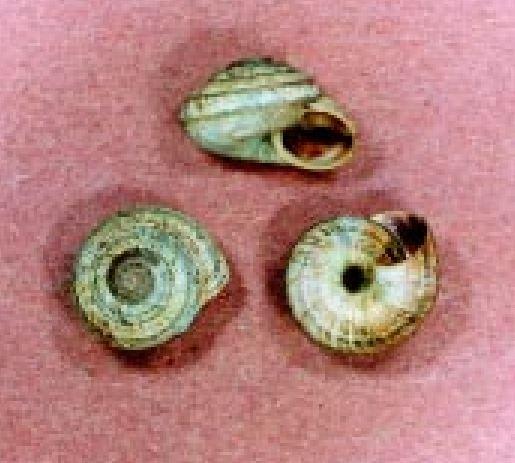Low-
Moderate
The population size of Chelan mountainsnail, a Washington endemic, is critical and has a declining trend.
Mountainsnails are terrestrial gastropods of western North America. Many mountainsnail species and subspecies have specialized habitat requirements and very restricted ranges, low ability to disperse, and are vulnerable to disturbances such as logging, fire, unsustainable grazing, or introduced predators.
Most mountainsnail species and subspecies (roughly 91 percent) are considered imperiled or critically imperiled by NatureServe.
Description and Range
Physical description
Taxonomic note: Many of the Oreohelicidae that are considered distinct species are not yet formally described, and it is likely that additional rare species of Oreohelix will be discovered with further investigation.
Ecology and life history
Oreohelix species are often associated with limestone outcrops, or areas with soil or rock with a fair percentage of lime.
Habitat of the Chelan mountainsnail is generally open Douglas-fir and ponderosa pine; this species has been found in two types of habitats broadly described as: 1) in schist talus, and 2) in litter or under shrubs in and adjacent to open dry forest stands with pinegrass or elk sedge understory. The typical site occurs within concave landforms that accumulate and maintain moisture more efficiently than the surrounding landscape. Elevations range from 1200 to 2600 feet; site aspect is variable
Mountainsnails eat leaf litter, detritus, and microorganisms on the surface of logs, rocks, or soil.
These snails are hermaphroditic, having both male and female organs. They are live-bearers; the eggs hatch before leaving the uterus of the parent, and they raise their young within their shells until they reach a certain size.
It is not known how long they live, or how often they reproduce.
Geographic range
The Chelan mountainsnail is a local endemic of the eastern foothills of the Cascades in central Washington. Populations of the Chelan mountainsnail are few, small, and scattered. Its known range covers about 270 square miles in eastern Chelan County. Within this area this snail has been found at less than 10 sites from about one-fourth acre to 10 acres in size.
Most of the sites are scattered, ranging from less than one acre to a few acres in size, and only one individual was observed (seven sites destroyed in the 1994 Tyee Fire were those of the Entiat mountainsnail, erroneously identified as this species). Sites are scattered within an area roughly bounded by the Columbia River on the southeast, Lake Chelan on the northwest to include the Twentyfive Mile Creek drainage, then southwest to Tyee Mountain, south to Chumstick Mountain, and following the ridge south and southeast to Burch Mountain, then south to the confluence of the Wenatchee and Columbia Rivers.
Climate vulnerability
Sensitivity to climate change
Low
There is limited information on the sensitivity of this species to climate change. The Chelan mountainsnail is typically found in schist talus habitat and in detritus or under shrubs with pinegrass or elk sedge understory at elevations ranging from 365 to 800 meters. This species may exhibit sensitivity to disturbances including wildfire, landslides, and habitat alterations that may shift the temperature and moisture regimes of preferred habitat types.
Exposure to climate change
Moderate-
High
- Altered fire regimes
Conservation
Conservation Threats and Actions Needed
- Resource information collect needs
- Threat: Need taxonomic clarification
- Action Needed: Taxonomic clarification; delineate occupied habitat
- Fish and wildlife habitat loss or degradation
- Threat: Fires; road building, unsustainable logging
- Action Needed: Need to identify core habitat sites and protect alteration
- Invasive and other problematic species
- Threat: Predation by wild turkeys
- Action Needed: Increase turkey harvest, if needed
See the Climate vulnerability section for information about the threats posed by climate change to this species.
Resources
References
Burke, T. E. 2013. Land Snails and Slugs of the Pacific Northwest. Oregon State University Press, Corvallis, OR. 344 pp.
Duncan, N. 2005. Conservation Assessment for Oreohelix n. sp. 1, Chelan Mountainsnail. Originally issued as: Burke, T. E. Management Recommendations, February 1999. Revised October 2005. USDA Forest Service Region 6 and USDI Bureau of Land Management, Oregon and Washington. 22 pp.,
Gaines, W. L., A. L. Lyons, K. Weaver, and A. Sprague. 2011. Monitoring the short-term effects of prescribed fire on an endemic mollusk in the dry forests of the eastern Cascades, Washington, USA. Forest Ecology and management 261:1460-1465.
Jepsen, S., A. Carleton, and S. F. Jordan. 2012. Spring 2012 Blue Mountains terrestrial mollusk surveys. Final report to the Interagency Special Species Status/Sensitive Species Program. The Xerces Society for Invertebrate Conservation. 88 pp.
USFWS. 2011. Endangered and Threatened Wildlife and Plants: 90-day finding on a petition to list 29 mollusk species as threatened or endangered with critical habitat: proposed rule. Federal Register 76 (No. 193, October 5, 2011): 61826-61853.
